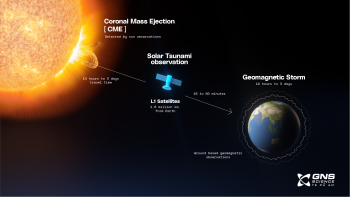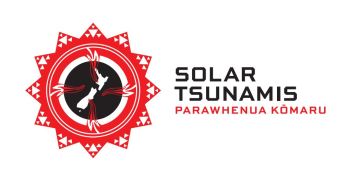
Space weather and geomagnetic data
Updated: Thu Feb 27 2025 10:00 AM
While most of Aotearoa New Zealand are familiar with the natural hazards that can cause severe damage and disruption across our nation. Some less familiar hazards you may have noticed in the media recently are space weather, solar tsunamis, and solar storms. So, what exactly are we talking about and what part does GNS Science play in preparing New Zealand for this natural hazard?
Activity on the Sun’s surface creates what we call space weather which can impact our national infrastructure, technology, and communications systems. Did you see the aurora australis in the sky earlier this year? That’s space weather in action.
GNS Science is one of many geomagnetic teams across the globe that measure and monitor the Earth's magnetic field and how it is being impacted by space weather events. And what’s exciting is that geomagnetic data is now available close to real-time on the GeoNet website.
GNS Science currently operates a magnetic observatory north-west of Christchurch, and at Scott Base in Antarctica. We also help with support to the Apia Geomagnetic Observatory in Samoa, run by the Samoan Government.
We continuously record changes in the Earth’s magnetic field at these geomagnetic observatories using instruments that we call magnetometers. These magnetometers can record the rapid changes of the Earth’s magnetic field (also known as geomagnetic field changes) associated with solar storms, as well as other geologic processes.
Read: Solar storm and beautiful aurora in May 2024
How do we know a geomagnetic storm is coming?
Space weather prediction centres around the globe watch the sun’s activity closely and provide a warning that a geomagnetic storm is coming. Three major prediction centres are located in America (SWPC) England (MOSWOC),and Australia (ASWFC).
An extreme solar event like a coronal mass ejection (CMEs), explosions of plasma and magnetic fields from the sun that are ejected out into space, can be detected when they occur and if they are roughly directed toward Earth.
The travel time for this solar activity from the sun to our next point of contact, the L1 satellites, is between 14 hrs and 3 days. It then takes 15 minutes to an hour, before it will reach Earth and be picked up by our magnetometers. We will then continue to record solar activity for hours to days from their arrival.
The time between a solar event happening and the activity reaching earth allows organisations like Transpower to engage their contingency plans for geomagnetic storms, and do their best to reduce damage, while continuing to supply us with electricity.
Learn: What are Coronal Mass Ejections (CMEs)
Read: Space Weather
GeoMagnetic Data now on our website
Real-time data from our two magnetometers located north-west of Christchurch is now available on our website, through a new dashboard. All GeoNet data is open and freely available to everyone in New Zealand and internationally. This tool helps us monitor Space Weather events arriving in New Zealand. We can identify the onset of a geomagnetic storm, how it evolves and when it ends.
Our System Development team worked hard to get this vital dashboard ready to provide data to Transpower in time for the recent sunspot cluster that produced the 10-11 May solar storm, for when it faced Earth again, after it survived its 27-day rotation around the sun.
This data helps the Transpower control room operators to verify how their power transmission system gets impacted by a geomagnetic storm. What Transpower is concerned about during such an event are geomagnetically induced currents (GICs), electrical currents induced in electrical power transmission systems during geomagnetic storms, which can potentially cause disruption and damage to the power transmission system. Transpower has been measuring GICs across the country since 2001, and now has 72 special sensors on transformers. Research lead by the University of Otago has shown a correlation between those GIC measurements and the rate of change in the horizontal intensity of the magnetic field measured at the geomagnetic observatory in Canterbury. This relationship allows us to provide a real-time space weather monitoring tool to Transpower.
Transpower Head of Grid and System Operations Matthew Copland said: “Transpower is continuing to work with research scientists and organisations including GNS Science and Otago University to develop this monitoring network and ensure we are armed with the quality information we need to respond to this natural hazard.”
Read: About the data
View: Data and geomagnetic dashboard
Solar Tsunamis programme
This work is part of the Solar Tsunamis Endeavour Programme, an international collaboration led by the University of Otago to understand how New Zealand’s energy infrastructure will be impacted by an extreme space weather event.
Media contact: 021 574 541 or media@gns.cri.nz






